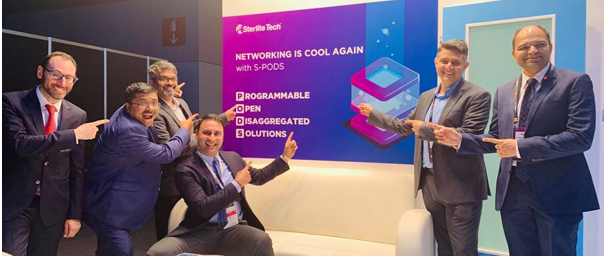We discuss the following topics in this blog:
- FTTx MANTRA – A fully-integrated, ready-to-implement FTTx solution
- TruRibbon – A fully backward compatible cable built for high-capacity networks.
- O-RAN Alliance – To leverage open-source software for building near real-time controllers for 5G.
In addition to these topics, we shall also be answering the following FAQs:
- What is WiFi?
- What is an Optical Fibre Cable?
From FTTH Conference to MWC 2019… From FTTx MANTRA to TruRibbon launch… It all happened in a month…

Our continued focus on innovation and investment in strengthening our research capabilities culminated into the launch of disruptive solutions for accelerating digital reinvention. Right from fully-integrated FTTX solution, a fully backward compatible ribbon cable – TruRibbon, to O-RAN Alliance; we made major announcements in three global events.
Contents
FTTx MANTRA – A fully-integrated, ready-to-implement FTTx solution
At the FTTH Conference 2019 in Amsterdam, we launched FTTx MANTRA, an end-to-end solution that empowers CSPs to swiftly roll-out FTTx networks at massive scale, near-zero response time, great agility, and at optimised costs. It integrates Sterlite Tech’s unique silicon-to-software capabilities across programmable networks, optical communication products, network design services and roll-outs, and software solutions.

TruRibbon – A fully backward compatible cable built for high-capacity networks
We have launched our TruRibbon at the Optical Networking and Communication Conference (OFC 2019) in San Diego. TruRibbon is a fully backward compatible ribbon cable with superior handling design, offering the high density needed for today’s smarter networks. Optimised for the first-time-right installation, TruRibbon offers unique benefits, bringing tremendous time and cost saving in fibre network roll-outs.

O-RAN Alliance – To leverage open-source software for building near real-time controllers for 5G
At MWC 2019 held in Barcelona, we announced our O-RAN Alliance, a global carrier-led consortium that promotes software-based, extensible Radio Access Network (RAN). By enabling programmability right at the core of the network, our Programmable Open Disaggregated Solutions (PODS) empowers CSPs to affordably upgrade, monitor and scale their networks, while enhancing their customers’ experience. In another major announcement, we have launched our Digital Reinvention portfolio to accelerate CSPs’ digital reinvention journey. This next-gen integrated portfolio encompasses best-in-class software and solutions that transform every aspect of CSPs’ business to make digital reinvention simpler and faster.

Technology innovation and deep customer connect are at the core of everything we do. As data requirements continue to explode unabated, we remain focused on solving our customer needs by launching disruptive solutions that transform everyday living.
FAQs
What is WiFi?
Put simply, WiFi is a technology that uses radio waves to create a wireless network through which devices like mobile phones, computers, printers, etc., connect to the internet. A wireless router is needed to establish a WiFi hotspot that people in its vicinity may use to access internet services. You’re sure to have encountered such a WiFi hotspot in houses, offices, restaurants, etc.
To get a little more technical, WiFi works by enabling a Wireless Local Area Network or WLAN that allows devices connected to it to exchange signals with the internet via a router. The frequencies of these signals are either 2.4 GHz or 5 GHz bandwidths. These frequencies are much higher than those transmitted to or by radios, mobile phones, and televisions since WiFi signals need to carry significantly higher amounts of data. The networking standards are variants of 802.11, of which there are several (802.11a, 802.11b, 801.11g, etc.).
What is an Optical Fibre Cable?
An optical fibre cable is a cable type that has a few to hundreds of optical fibres bundled together within a protective plastic coating. They help carry digital data in the form of light pulses across large distances at faster speeds. For this, they need to be installed or deployed either underground or aerially. Standalone fibres cannot be buried or hanged so fibres are bunched together as cables for the transmission of data.
This is done to protect the fibre from stress, moisture, temperature changes and other externalities. There are three main components of a optical fibre cable, core (It carries the light and is made of pure silicon dioxide (SiO2) with dopants such as germania, phosphorous pentoxide, or alumina to raise the refractive index; Typical glass cores range from as small as 3.7um up to 200um), Cladding (Cladding surrounds the core and has a lower refractive index than the core, it is also made from the same material as the core; 1% refractive index difference is maintained between the core and cladding; Two commonly used diameters are 125µm and 140µm) and Coating (Protective layer that absorbs shocks, physical damage and moisture; The outside diameter of the coating is typically either 250µm or 500µm; Commonly used material for coatings are acrylate,Silicone, carbon, and polyimide).
An optical fibre cable is made up of the following components: Optical fibres – ranging from one to many. Buffer tubes (with different settings), for protection and cushioning of the fibre. Water protection in the tubes – wet or dry. A central strength member (CSM) is the backbone of all cables. Armoured tapes for stranding to bunch the buffer tubes and strength members together. Sheathing or final covering to provide further protection.
The five main reasons that make this technology innovation disruptive are fast communication speed, infinite bandwidth & capacity, low interference, high tensile strength and secure communication. The major usescases of optical fibre cables include intenet connectivity, computer networking, surgery & dentistry, automotive industry, telephony, lighting & decorations, mechanical inspections, cable television, military applications and space.















